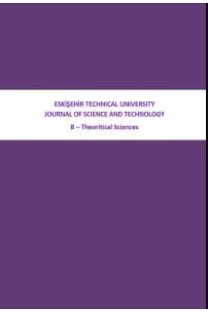DETECTION OF COLLAPSED BUILDING FROM UNMANNED AERIAL VEHICLE DATA WITH OBJECT BASED IMAGE CLASSIFICATION
Collapsed Building, Object Based Classification, Remote Sensing, UAV
___
- [1] Sumer, E. and M. Turker, Building damage detection from post-earthquake aerial images using watershed segmentation in Golcuk, Turkey. International Society for Photogrammetry and Remote Sensing ISPRS, 2004: p. 642-647.
- [2] Jiang, N., et al., Object-oriented buinding extraction by DSM and very high-resolution orthoimages. The International Archives of the Photogrammetry, Remote Sensing and Spatial Information Sciences, 2008. 37: p. 441-446.
- [3] Yano, Y., et al. Building damage detection of the 2003 Bam, Iran earthquake using QuickBird images. in Proceedings of the 25th Asian Conference on Remote Sensing. 2004. Citeseer.
- [4] Safarlou, F., Change Detectıon of Buildings from High Resolution Satellite Imagery And Existing Map Data Using Object Based Classification. 2015.
- [5] Teo, T.-A. and L.-C. Chen. Object-based building detection from LiDAR data and high resolution satellite imagery. in Proceedings of the 25th Asian Conference on Remote Sensing. 2004.
- [6] Rutzinger, M., et al. Object-based building detection based on airborne laser scanning data within GRASS GIS environment. in Proceedings of UDMS. 2006.
- [7] Miliaresis, G. and N. Kokkas, Segmentation and object-based classification for the extraction of the building class from LIDAR DEMs. Computers & Geosciences, 2007. 33(8): p. 1076-1087.
- [8] Hunt, E.R., et al., Acquisition of NIR-green-blue digital photographs from unmanned aircraft for crop monitoring. Remote Sensing, 2010. 2(1): p. 290-305.
- [9] Woebbecke, D.M., et al., Color indices for weed identification under various soil, residue, and lighting conditions. Transactions of the ASAE, 1995. 38(1): p. 259-269.
- [10] Hunt Jr, E.R., et al., A visible band index for remote sensing leaf chlorophyll content at the canopy scale. International Journal of Applied Earth Observation and Geoinformation, 2013. 21: p. 103-112.
- [11] Baatz, M., et al., eCognition user guide. Definiens Imaging GmbH, Munich, Germany, 2004.
- [12] Tucker, C.J., Red and photographic infrared linear combinations for monitoring vegetation. Remote sensing of Environment, 1979. 8(2): p. 127-150.
- [13] Gitelson, A.A., et al., Novel algorithms for remote estimation of vegetation fraction. Remote sensing of Environment, 2002. 80(1): p. 76-87.
- [14] Mao, W., Y. Wang, and Y. Wang. Real-time detection of between-row weeds using machine vision. in 2003 ASAE Annual Meeting. 2003. American Society of Agricultural and Biological Engineers.
- ISSN: 2667-419X
- Yayın Aralığı: Yılda 2 Sayı
- Başlangıç: 2010
- Yayıncı: Eskişehir Teknik Üniversitesi
BETONARME BİNALARIN PATLAYICI KULLANILARAK İÇE YIKIMINDA BETON DAYANIMININ YAPI DAVRANIŞINA ETKİSİ
Hakan ÖZMEN, Kurtuluş SOYLUK, Özgür ANIL
DOLGU DUVARLARIN DÜZLEM DIŞI YÖNDE HAVA YASTIĞI İLE DENEYİ
İsmail Ozan DEMİREL, Ahmet YAKUT, Baris BİNİCİ
ESKİŞEHİR ALÜVYON FORMASYONUNUN KONUMSAL DEĞİŞKENLİĞİNİN CPT ÖLÇÜMLERI İLE BELİRLENMESİ
Emrah PEKKAN, Muammer TÜN, Sunay MUTLU
NATURAL CHARACTERISTICS AND NONLINEAR BEHAVIOR OF A NEW RC FORMWORK SYSTEM
Cavit SERHATOĞLU, Quy Thue NGUYEN, Ramazan LİVAOĞLU
DÜŞÜK VE ORTA YÜKSEKLİKTEKİ BİNALARDA ÇEKİÇLEME ETKİSİ
Muhammet KAMAL, Mehmet İNEL, Bayram Tanik ÇAYCI
Resul ÇÖMERT, Dilek Küçük MATCI, Uğur AVDAN
İNSANSIZ HAVA ARAÇLARININ AFET YÖNETİMİNDE KULLANIMI
Murat UYSAL, Mustafa YILMAZ, İbrahim TİRYAKİOĞLU, Nizar POLAT
KÜTAHYA YEŞİL MİNARENİN KAPALI VE AÇIK ŞEREFELİ DİNAMİK DAVRANIŞLARININ KARŞILAŞTIRILMASI
Mahmud Sami DÖVEN, Cavit SERHATOĞLU, Onur KAPLAN, Ramazan LİVAOĞLU
DEPREMLERDE GÖZLENEN ETKİLERİN GÖNÜLLÜ KATILIMIYLA HIZLI BİR ŞEKİLDE TOPLANMASI
Muammer TÜN, Emrah PEKKAN, Sunay MUTLU
